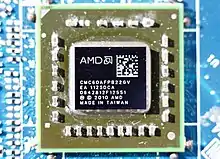| General information | |
|---|---|
| Launched | early 2011 |
| Discontinued | present |
| Common manufacturer(s) | |
| Architecture and classification | |
| Technology node | 40 nm |
| Instruction set | AMD64 (x86-64) |
| Physical specifications | |
| Socket(s) |
|
| Products, models, variants | |
| Core name(s) | |
| History | |
| Successor(s) | Jaguar - Family 16h |
The AMD Bobcat Family 14h is a microarchitecture created by AMD for its AMD APUs, aimed at a low-power/low-cost market.[1]
It was revealed during a speech from AMD executive vice-president Henri Richard in Computex 2007 and was put into production Q1 2011.[2] One of the major supporters was executive vice-president Mario A. Rivas who felt it was difficult to compete in the x86 market with a single core optimized for the 10–100 W range and actively promoted the development of the simpler core with a target range of 1–10 W. In addition, it was believed that the core could migrate into the hand-held space if the power consumption can be reduced to less than 1 W.
Bobcat cores are used together with GPU cores in accelerated processing units (APUs) under the "Fusion" brand.[3][4] A simplified architecture diagram was released at AMD's Analyst Day in November 2009. This is similar in concept with earlier AMD research in 2003,[5] detailing the specifications and advantages of extending x86 "everywhere".
Design
The Bobcat x86 CPU core design has since been completed and implemented in AMD APU processor products with a TDP of 18 W or less. The core is targeted at low-power markets like netbooks/nettops, ultra-portable laptops, consumer electronics and the embedded market. Since its launch, Bobcat-based CPUs have also been used by OEMs on larger laptops. Architecture specifics:[6]
- 64-bit core
- Out-of-order execution
- Advanced branch predictor
- Dual x86 instruction decoder
- 64-bit integer unit with two ALUs
- Floating-point unit with two 64-bit pipes
- Single channel 64-bit memory controller
- 32 KiB instruction + 32 KiB data L1 cache
- 512 KiB - 1 MiB L2 cache
- MMX, SSE, SSE2, SSE3, SSSE3, SSE4A, ABM
In February 2013, AMD detailed plans for a successor to Bobcat codenamed Jaguar.
Features
APU features table
Processors
In January 2011 AMD introduced several processors that have implemented the Bobcat core. This core is in the following AMD Accelerated Processors:[6][7][8]

| Series ^ | Model | CPU clock (MHz) | CPU cores | TDP (W) | L2 cache (KiB) | Radeon cores | GPU clock (MHz) | DirectX version | UVD | DDR3 speed |
|---|---|---|---|---|---|---|---|---|---|---|
| C-Series | C-30 | 1000 | 1 | 9 | 512 | 80 | 277 | 11 | UVD 3 | 1066 |
| C-50 | 2 | 2*512 | 276 | |||||||
| C-60 | 1000/1333 (turbo) | 276/400 (turbo) | ||||||||
| C-70 | ||||||||||
| E-Series | E-240 | 1500 | 1 | 18 | 512 | 500 | ||||
| E-300 | 1300 | 2 | 2*512 | |||||||
| E-350 | 1600 | 492 | ||||||||
| E-450 | 1650 | 508/600 (turbo) | 1333[9] | |||||||
| E1-1200 | 1400 | 500 | 1066 | |||||||
| E1-1500[10] | 1480 | 529 | ||||||||
| E2-1800 | 1700 | 523/680 | 1333 | |||||||
| E2-2000[10] | 1750 | 538/700 | ||||||||
| G-Series | T-24L | 800 | 1 | 5 | 512 | ? | 1066 | |||
| T-30L | 1400 | 18 | 1333 | |||||||
| T-40N | 1000 | 2 | 9 | 2*512 | 276 | 11 | UVD 3 | 1066 | ||
| T-44R | 1200 | 1 | 512 | |||||||
| T-48E | 1400 | 2 | 18 | 2*512 | 280 | |||||
| T-48L | ? | |||||||||
| T-48N | 492 | 11 | UVD 3 | |||||||
| T-52R | 1500 | 1 | 512 | |||||||
| T-56N | 1600 | 2 | 2*512 | |||||||
| Z-Series | Z-01 | 1000 | 5.9 | 276 | ||||||
| Z-60[11] | 4.5 | 275 | ||||||||
^ E-Series & C-Series are standard parts, G-Series are embedded parts
See also
- Bulldozer, a new core for the 10 to 125 Watt TDP range.
- List of AMD processors with 3D graphics
References
- ↑ "List of AMD CPU microarchitectures - LeonStudio". LeonStudio - CodeFun. 3 August 2014. Archived from the original on 26 September 2020. Retrieved 12 September 2015.
- ↑ Hruska, Joel (July 16, 2010). "AMD Flip-Flops: Llano Later, Bobcat Bounding Forward". HotHardware. Archived from the original on July 21, 2010. Retrieved July 17, 2010.
- ↑ Gunning for Mobilty: Intel and AMD Bet on a Mobile Internet, Dailytech.com, 2007-06-13, archived from the original on 2014-02-02, retrieved 2012-01-27
- ↑ "Analyst Day 2009 Presentations". AMD. November 11, 2009. Archived from the original on April 17, 2017. Retrieved 2009-11-14.
- ↑ AMD 2003 Microprocessor Forum Slides: Slide 11 and Slide 22
- 1 2 AMD Embedded G-Series Platform (PDF), AMD, archived from the original (PDF) on 2013-09-11, retrieved 2012-01-27
- ↑ AMD Accelerated Processors for Mainstream Notebooks, AMD, 2012-01-17, retrieved 2012-01-27
- ↑ All-In-One Desktops With AMD Accelerated Processors, AMD, retrieved 2012-07-02
- ↑ The Brazos Update: AMD's E-450, Anandtech.com, 2011-06-01, retrieved 2012-01-27
- 1 2 Notebooks AMD.com
- ↑ Tablets AMD.com